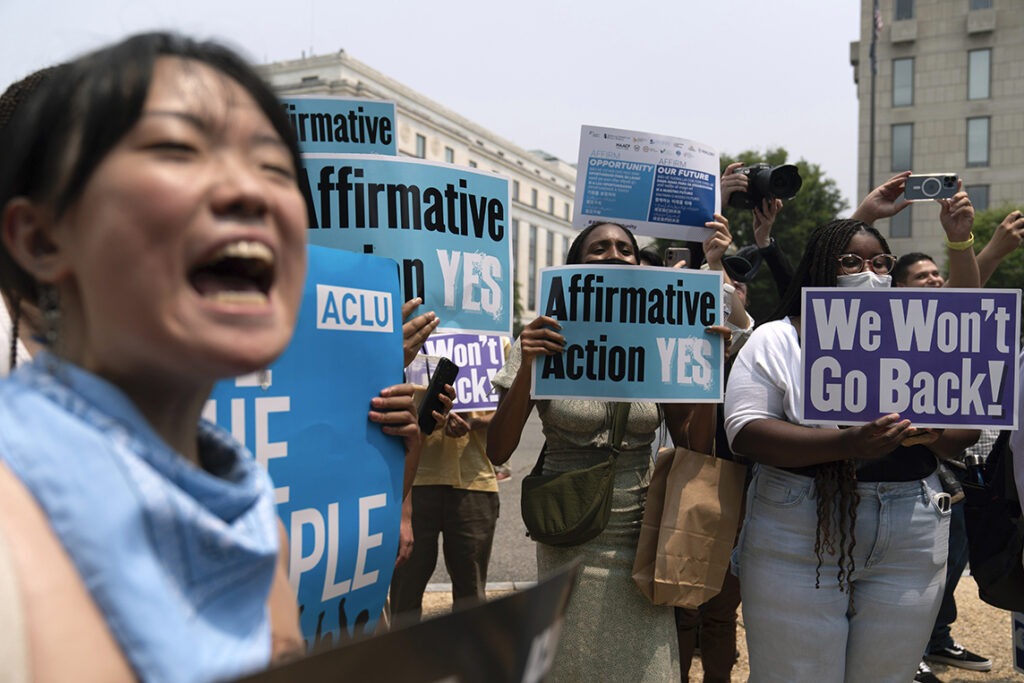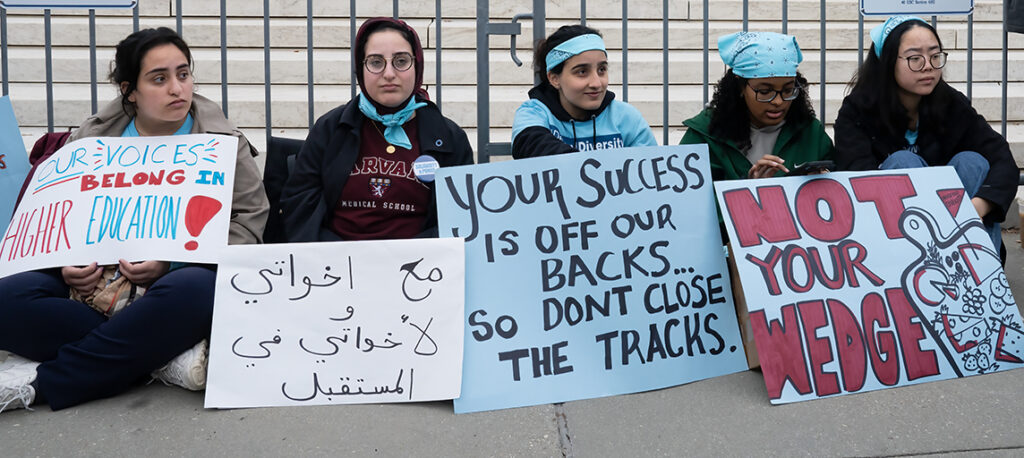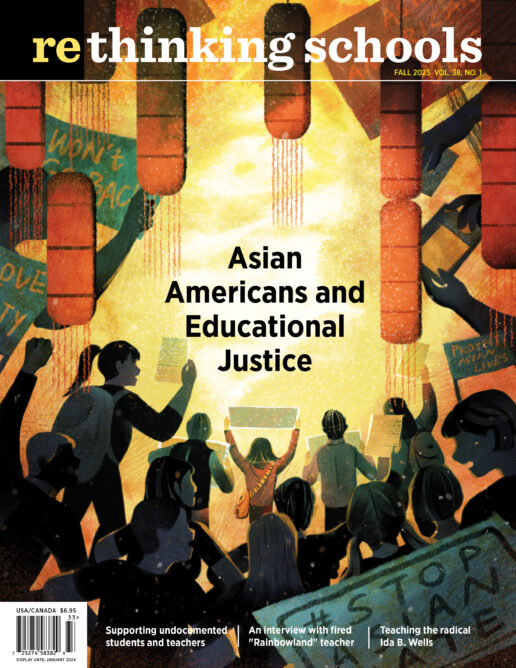“Isn’t that what the case is about, the discrimination against Asian Americans?”
Conservatives Use Racial Wedge to Attack Affirmative Action

Conservative whites have sought to end affirmative action in university admissions for decades. In the 1978 University of California v. Bakke, Allan Bakke, a white applicant turned down by several medical schools, claimed he did not get into programs because other, less qualified non-whites were admitted. In the Bakke decision, the Supreme Court upheld that race could be considered as one among a number of factors for admission. Nonetheless, the Bakke decision was considered a blow to affirmative action because racial quota systems were deemed illegal, and activists felt it was the first step toward ending affirmative action altogether.
In 1997, Barbara Grutter, a white woman, sued the University of Michigan Law School, accusing that the school’s race-conscious admissions was not constitutional. That same year, Jennifer Gratz, also a white woman, sued the University of Michigan when she was not admitted for undergraduate studies. The conservative Center for Individual Rights supported both cases. The Supreme Court upheld the Michigan Law School policy but struck down the undergraduate policy.
In 2008, Edward Blum recruited Abigail Fisher, a white woman, to sue the University of Texas at Austin for its race-conscious admissions policy. This resulted in two separate rulings. In the 2013 Fisher I ruling, the U.S. Supreme Court sent the case back to the Fifth Circuit to be reviewed. The Fifth Circuit found that the university’s policy met the legal requirements outlined in Grutter. Fisher appealed, and in the 2016 Fisher II ruling, the U.S. Supreme Court affirmed the constitutionality of the University of Texas at Austin’s admissions policy.
Edward Blum is an important character here. A white, conservative, failed congressional candidate from Texas, he was behind several court cases regarding redistricting and voting, including Shelby County v. Holder, which gutted protections in the Voting Rights Act that supported more voters of color. According to Slate, between 2015 and 2020, Blum’s two nonprofits received $11.2 million (while he drew $900,000 in salary) from the ultra-conservative Searle Freedom Trust, the Scaife Foundation, the Bradley Foundation, and Donors Trust — itself funded by the Koch and DeVos families.
In 2014, as Fisher II was still in process, Blum founded Students for Fair Admissions (SFFA). That same year, the SFFA sued the University of North Carolina at Chapel Hill and Harvard University for discriminatory admissions policies. Using anonymous Asian Americans as plaintiffs, the Harvard suit charged that the university was functionally using racial quotas to deny Asian Americans admission, and that admissions should be based solely on standardized test scores and similar metrics.
The Asian American Wedge
After the Fisher II ruling, Blum said, “I needed Asian plaintiffs,” and he has been purposeful in using Asian Americans to propel his well-funded anti-affirmative action campaign ever since. As he formed the SFFA, Blum sought out Asian Americans through community events and websites to further challenge affirmative action. Blum’s organizations accessed networks of conservative Asian American activists, themselves funded by right-wing think tanks like the Pacific Legal Foundation, and tapped Chinese immigrant leaders to help organize demonstrations against affirmative action.
Blum’s thinking was not new. Legal scholar Claire Jean Kim argues, Asian Americans have long been used as racial “spoilers” in affirmative action arguments. In the 1978 Bakke ruling, for instance, Supreme Court Justice Lewis Powell used Asian American achievement as a foil to arguments that systematic “social discrimination” exists, even as he made arguments in favor of using race as one factor in college admission on the grounds that diversity was an important goal. Similarly, in his dissent of the Fisher II ruling in 2016, Justice Samuel Alito argued that Asian Americans should qualify for affirmative action admissions programs given the amount of discrimination they have overcome.
Given popular media coverage and Blum’s tactics, you would think that the SFFA case was really Asian Americans vs. Affirmative Action. At one point during the trial, Justice Roberts interrupted a Harvard lawyer to ask, “Isn’t that what the case is about, the discrimination against Asian Americans?”
In reality, a small but vocal minority of anti-diversity Asian Americans has been given an oversized platform in this debate, while the true relationship between Asian Americans and affirmative action has been lost.

(Victoria Pickering | FlickrCreativeCommons)
Asian Americans and Affirmative Action
Historically, Asian American activists led calls for affirmative action programs and admissions processes that are equitable for communities of color. Well before the recent spate of high-profile cases Asian Americans had fought for affirmative action and fair university admissions. Author Jeff Chang explains: “As early as the 1950s, after the mass incarceration of Japanese Americans, Asian Americans called for affirmative action programs for racially excluded minorities. From the 1960s through the 1980s, Asian Americans helped force higher education open for excluded communities of color and benefited from affirmative action programs.”
For instance, in 1986, when some affirmative action programs excluded Asian Americans, UC Berkeley professor Ling-Chi Wang noticed that Asian American enrollment at Berkeley had leveled out, and through his investigation he discovered that Asian students were being denied enrollment through unofficial decision-making admission processes — referred to as “negative action” in admissions.
Chang, a student organizer at Berkeley at the time, explains, “We were able to get the University of California to actually admit that they had discriminated against Asian Americans by dis-advantaging them in what were supposed to be head-to-head, merit-based types of competitions between Asian and white students.” Others in the Asian American community saw similar trends at elite universities like Yale, Harvard, Stanford, Brown, and UCLA, and, as part of a broader movement for college access for all non-white racial groups, they pressured these universities (sometimes successfully) to become more transparent in their admissions processes.
This legacy of Asian American support for college access has not disappeared. According to the 2020 Asian American Voter Survey, 70 percent of Asian Americans support affirmative action when it is understood as a program to help “minority” groups get access to higher education, while 16 percent are opposed (with the remaining being indifferent or not knowing what affirmative action was). AAPI Data 2021 shows that Chinese American attitudes toward affirmative action have shifted, with 41 percent supporting affirmative action in 2016 increasing to 56 percent supporting in 2021.
Conservatives Flip the Script
Regardless of Asian American historical and contemporary support for affirmative action, conservatives seized on the Asian American struggles for justice in admissions in the 1980s and inverted it for their anti-affirmative action campaign. White conservatives like Congressman Dana Rohrabacher and columnist George Will co-opted and reframed the “negative action” against Asian Americans to be the same as “affirmative action” since, according to their logic, preferential racial quotas that favored specific groups over individual merit were inevitable once race was a consideration in college admissions. Since then, white conservatives began to claim Asian American protests against discrimination in admissions as part of their campaign against affirmative action.
With the recent successful SFFA challenge to affirmative action, we see a small but vocal number of conservative Asian Americans — many of whom are Chinese American — with support from conservative whites like Blum being used to advance a white supremacist cause of ending admissions practices that attempt to remediate institutionalized racism. Scholars Oiyan Poon and Megan Segoshi have written about how conservative Asian Americans have been used (and used themselves) as “racial mascots” in the anti-affirmative action campaigns.
Conservative Asian Americans and the Logic of Meritocracy
Given the history of Asian American discrimination in university admissions in the 1980s, as well as the spike in anti-Asian violence in recent years, it is easy to understand the fear and insecurities driving Asian Americans opposing affirmative action. One of their core beliefs is that a discriminatory “Asian penalty” keeps them out of universities. In turn, this thinking leads them to believe that seats in universities that should go to Asian Americans are wrongfully filled by “less qualified” Black and Latinx students, admitted through affirmative action programs.
Within this logic, using holistic admissions criteria appears to create an unjust double standard for college admissions that manifests as anti-Asian bias: Asian Americans succeed in the white people’s game of American success and now you penalize us for it?! Scholar Natasha Warikoo recalled that during a panel on education, one Asian American woman in the audience explained, “You know, just as we figure out your system of meritocracy, it feels like you’re pulling the rug from underneath us.”
For conservative white and conservative Asian Americans alike, the solution to the “problem” of affirmative action is clear: high-stakes, standardized tests as a true and objective measure of merit for university admission.
In the words of Yukong Zhao, president of the conservative Asian American Coalition for Education: “Abolishing standardized testing is a dangerous assault on American meritocracy by radical progressives. Without a fair and transparent process offered by standardized tests, our colleges cannot select and educate the best and brightest to make critical contributions to our economic prosperity, technological leadership and national security.”
Testing, Asian Americans, and Holistic Admissions
As I’ve written in Rethinking Schools and elsewhere, high-stakes, standardized tests are not objective measures of student merit. Instead, they perpetuate inequities associated with white supremacy and capitalism. They sort students into a hierarchical “bell curve” of inequality. Decades of research show that tests reproduce the same race and class inequities. Statistically, test scores correlate most strongly with socioeconomic class. There is nothing objective about standardized test scores. They are inaccurate, do not measure “merit,” and should not be used for university admissions.
Misuse and misunderstanding of tests aside, research shows that not only is the idea that Asian Americans are being denied admissions to universities a myth, but also that limiting college admissions to only test scores will not significantly increase the number of admitted Asian American students.
In their study of Asian American college admissions using almost 20 years of data, researchers Anthony Carnevale and Michael Quinn found no strong evidence that universities create caps on Asian American enrollment — even if the proportion of Asian Americans with high test scores attending universities has remained remarkably consistent, and that, yes, Asian American acceptance rates at the most selective colleges are lower than other groups (to explain the latter, the researchers found that Asian American students apply to highly selective colleges at much higher rates than other groups — making their rate of rejection higher by comparison).
Carnevale and Quinn also found that if college admissions were based purely on test scores, the percentage of Asian American students accepted into elite universities would rise by only 2 percentage points. One reason is that, according to the study, 40 percent of Asian American student test scores are considered “below average.” (Contrary to stereotype, not all Asians are good at tests.) This would result in one in five Asian American students not being admitted for not meeting the threshold, and perhaps ironically, denying admittance to those Asian American students who might have benefited from affirmative action programs.
It is also critical to understand that, although Asian Americans might be overrepresented in elite college admissions, they are represented proportionally in higher education generally. In 2019, Asian Americans made up roughly 5.9 percent of the U.S. population, and during the 2018–2019 school year Asian American undergraduates made up 6.6 percent of the total undergraduate college population. Granted, other non-white racial groups are extremely underrepresented in higher education, and some Asian American subgroups share in that extreme underrepresentation. However, contrary to popular notions of too many Asian American students admitted into universities, Asian Americans are perhaps the only racial group to be proportionately represented in higher education.
What is often left out of discussions of affirmative action is that white students are over-represented in college admissions. This over-representation is not just a product of historical inequities, but also ongoing racial discrimination in admissions processes that has negatively impacted non-white racial groups, including Asian Americans.
An August 2023 study by the National Bureau of Economic Research found that selective universities used geographic considerations and legacy admissions to discriminate against Asian American applicants in favor of white applicants. The researchers estimated that the odds for acceptance of Asian Americans were 28 percent lower than for white students with similar GPAs and test scores. South Asian American applicants in particular saw significantly lower odds (49 percent) than comparable white students.
What is often left out of discussions of affirmative action is that white students are over-represented in college admissions.
Defend Race Equity in Higher Education
We should not support Harvard’s admissions practices, even if they were one of the defendants in this historic anti-affirmative action lawsuit. Harvard is an elite — and elitist — university with a history of highly discriminatory admissions. In 2019, NBC News reported that 43 percent of the white student population admitted to Harvard are non-competitive admits as recruited athletes, children of staff, children of donors, or “legacy” children or grandchildren of Harvard alumni. A 2022 New Yorker article highlighted how 66 percent of Harvard students hail from the richest 20 percent of income earners. Harvard doesn’t want to democratize access to their institution because if they let everyone walk their hallowed halls, they would no longer be “elite.”
Similarly, we should not defend affirmative action as the cure to ending institutionalized racism in education. Affirmative action was never going to fix the problem, but it has been important to defend it as one potential gain in the struggle for racial equity in education, especially when it — along with critical race theory, anti-racism, LGBTQ students and communities, and educational justice generally — are all attacked by right-wing forces.
Implications for K–12 Education
In K–12, one of the sharpest fights revolves around testing, diversity, and admissions into elite high schools in cities like New York and San Francisco. Even though in 2007 the Supreme Court already ruled that race could not be considered for equity purposes in K–12 public school admissions (Parents Involved in Community Schools v. Seattle Public School District No. 1), the ending of affirmative action in higher education and arguments to focus on test scores bolsters conservative arguments against diversifying elite K–12 schools.
K–12 teachers could teach about the affirmative action ruling in several ways. For instance, there are a lot of misconceptions about affirmative action and about the Supreme Court cases. Teaching the reality and history of affirmative action could dispel myths and misunderstandings propagated through media.
Some arguments against affirmative action rely on the notion that high-stakes, standardized tests provide accurate and objective measures of student learning, hard work, and merit. Teachers can teach about the racist history of standardized testing and its origins in eugenics and white supremacy, as well as the inaccuracies of the tests and questions about what they really measure.
The stereotype of the model minority also lays at the heart of how Asian Americans have been used to attack affirmative action. Teachers could dispel the model minority stereotype by teaching about the immense ethnic, class, political, educational, and historical diversity that exists under the umbrella category of Asian American. Teaching about the roots of the model minority stereotype and how it was built as a form of anti-Blackness would be critical too. In addition, to combat how the model minority stereotype and struggles over affirmative action have divided communities of color, teachers could teach about instances of Asian Americans organizing in solidarity with other racial groups through organizations like the Third World Liberation Front, movements to found ethnic studies, protests over Vincent Chin’s murder, Asian American support for Black Lives Matter, and more recent multiracial protests against anti-Asian violence, among other possibilities.
Ultimately, whether it is about affirmative action or Asian Americans, conservatives and white supremacists rely on campaigns of misinformation, racist dog whistle politics, and a racial divide-and-conquer strategy to keep us splintered, and ultimately less effective. As always, the answer is to educate and organize.

